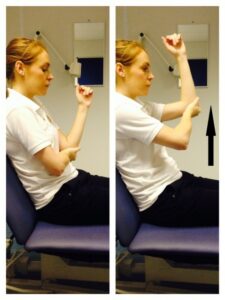This is a sprain to your shoulder
Healing:
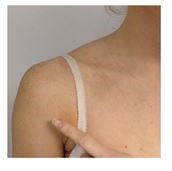
It normally takes 6 weeks to heal, but symptoms can continue for 3 months.
Smoking will slow down your healing. We would advise that you stop smoking while your injury heals. Talk to your GP or go to www.smokefree.nhs.uk for more information.
Pain and Swelling:
Your shoulder may be swollen and you will have some pain. Take pain medication as prescribed. You can use an ice pack or bag of frozen peas wrapped in a damp towel to help with your pain. Put this on your shoulder for up to 15 minutes every few hours. Make sure the ice is not in direct contact with your skin.
Wearing your sling:
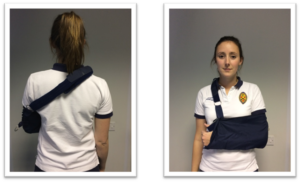
Your sling can be worn for comfort. You can take it off to wash, dress and exercise. It does not need to be worn at night. You should stop using your sling as soon as possible.
Exercise and activity:
It is important to keep your shoulder moving to prevent stiffness. You can return to activity when you feel ready. Start with light tasks and be guided by your pain.
Regular and exercise will prevent stiffness and improve your movement. You will find pictures and instructions for your exercises below. Start with Stage 1 Exercises. As soon as you feel ready you can progress to the next stages.
Follow up:
A follow up appointment is not normally needed for this injury. Please contact the Virtual Fracture Clinic if after 6 weeks you still have significant pain or swelling. We have discussed a referral to physiotherapy and will refer if required.
Contact us:
If you have any questions, are concerned about your symptoms or have pain other than at your shoulder please contact us.
Step 1 exercises
Hand, wrist and elbow exercises are only needed while you are wearing a sling. You can stop these once they become easy and you have full movement. Try to do these exercises 4-5 times a day. Repeat each exercise 10 times.
Hand, wrist, and elbow exercises:
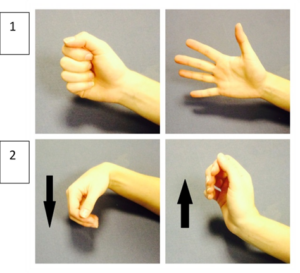
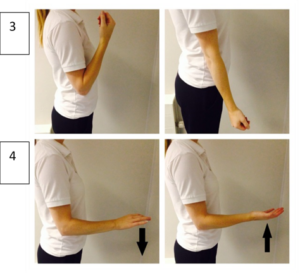
- Open and close your hand. Next, move you wrist up and down. Repeat 10 times.
- After a few days, hold a soft ball or rolled up socks. Squeeze the ball and hold for 5 seconds. Repeat 5 times.
- Bend and straighten your elbow 10 times.
- Bend your elbow to a right angle. Slowly turn your palm up to the ceiling and down to the ground. Repeat 10 times.
Posture Exercise:
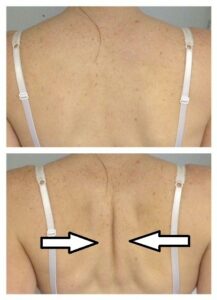
Bring your shoulders back and gently squeeze your shoulder blades together. Hold for 20-30 seconds. Repeat 5 times.
Shoulder Pendulum Exercise:
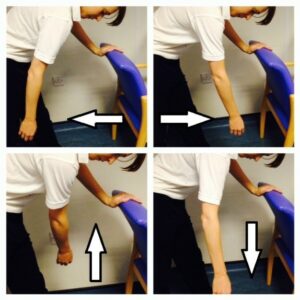
Stand next to a firm surface. Support yourself with your un-injured arm and lean forwards. Let your injured arm relax and hang down to the ground.
Gently swing your arm, making a small movement. Try to do this forward and backward, side to side and in small circles.
Aim to do this for 1-2 minutes in total. You do not need to push into pain. Remember to keep your arm relaxed.
Stage 2 exercises
You can start these exercises as soon as you are able to. Try to do these exercises 4-5 times a day. Repeat each exercise 10 times.
Active Assisted Flexion
Use your other hand to lift your injured arm up in front of you, as shown in these pictures.
Active Assisted External Rotation
Keep the elbow of your injured arm tucked into your side and your elbow bent. Hold onto a stick, umbrella or something similar.
Use your good arm to push your injured hand outwards. Remember to keep your elbow tucked in.
If you don’t have a stick, hold your injured arm at the wrist, guide it outwards with your good hand.
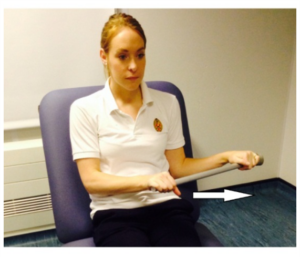
Stage 3 exercises
You can start these exercises as soon as you are able to do Stage 2 Exercises comfortably. Try to do these exercises 4-5 times a day. Repeat each exercise 10 times.
Active Flexion
Lift your arm forwards in front of you. Try to raise the arm as high as you can. You do not need to push into pain. If this is too difficult, try the same movement with a bent elbow.
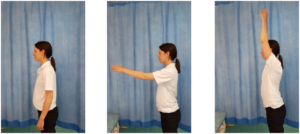
Active Abduction
With your palm facing forwards, move your arm out to the side in a big arc. Try to raise the arm as high as you can. You do not need to push into pain. If this is too difficult, try the same movement with a bent elbow.
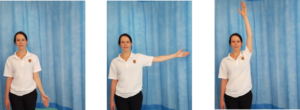
Active External Rotation
Start with your elbow bent by your side. Move your forearm out to the side, keeping your elbow bent and near your waist.
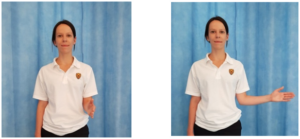
Frequently Asked Questions
I’m concerned about my symptoms and/or I am struggling to return to exercise
Please contact the Virtual Fracture Clinic.
When can I start driving?
You can return to driving when:
- You are no longer using a sling
- You can move comfortably
- You can control the vehicle safely
Always test your ability to drive in a safe environment first.
How can I get a certificate for work?
You can self-certify for the first 7 days following your injury. For any longer periods, please discuss the provision of a fitness to work statement with the Virtual Fracture Clinic Team, the Doctor at your Fracture Clinic appointment or your GP.
Contact Details for Bedford and Luton
Please contact the hospital where you attended A&E as the other site will not be able to access your notes
BEDFORD HOSPITAL PATIENTS
How do I contact the Virtual Fracture Clinic (VFC)
- Telephone 01234 792036
- Messages will be checked every morning Monday to Friday (except for Bank Holidays)
- Email VFCBedford@bedfordhospital.nhs.uk
How do I contact the Fracture Clinic?
- Telephone 01234 792138
How do I contact the Plaster Room?
- Telephone 01234 792031
- Monday to Friday 9am to 5pm (out of hours contact the Emergency Department)
LUTON & DUNSTABLE HOSPITAL PATIENTS
How do I contact the Virtual Fracture Clinic (VFC)
- Telephone 01582 718121
- Messages will be checked every morning Monday to Friday (except for Bank Holidays)
- Email VFCLuton@ldh.nhs.uk
How do I contact the Fracture Clinic?
- Telephone 01582 497194 or 01582 718 993 (outpatient appointments)
How do I contact the Plaster Room?
- Telephone 01582 491166 (ext. 2233)
- Monday to Friday 9am to 5pm (out of hours contact the Emergency Department)

